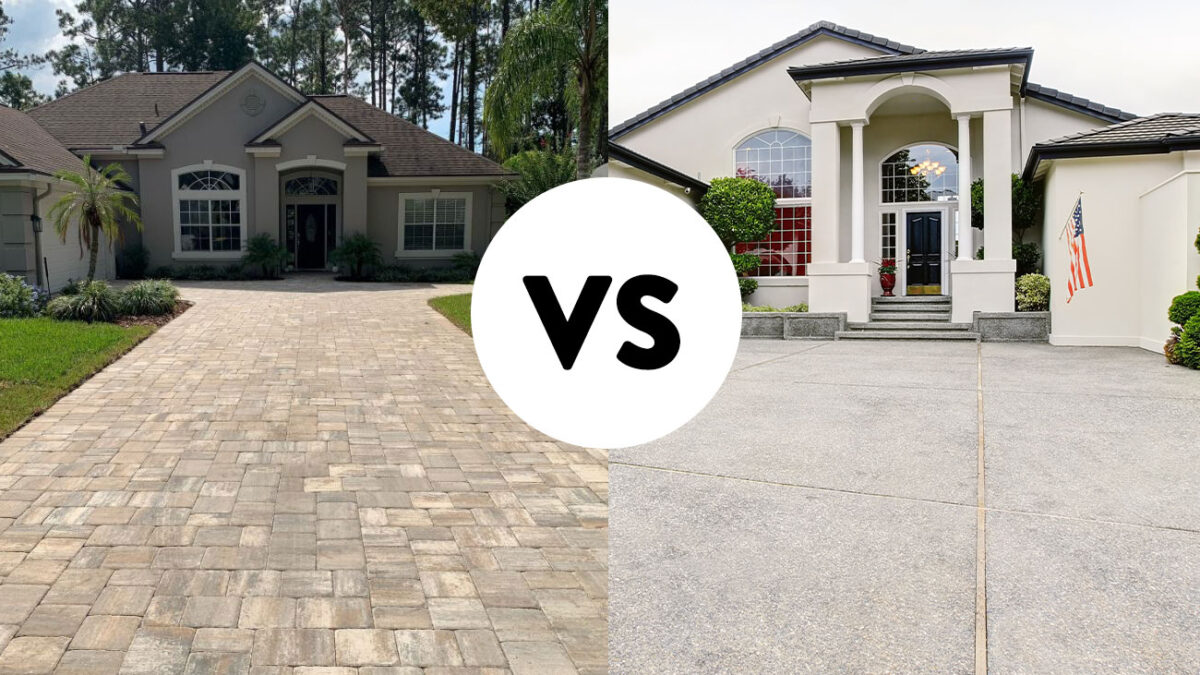

Is it Cheaper to Lay Concrete or Pavers?
When considering a new driveway or renovating an existing one, both options come with their own set of advantages, but the cost is invariably a significant factor in the decision-making process. Let’s look at the cost aspects of both to determine which might be the best choice for your situation.
Initial Costs
Concrete: Concrete driveways tend to be cheaper and have a lower initial cost. Putting in a concrete driveway involves preparing the ground, creating wooden forms, and then pouring and smoothing the concrete. The simplicity of this process, requiring fewer materials, often results in a lower upfront expense.
Pavers: Installing pavers is generally going to be more expensive.. This is mainly due to it being a more labor-intensive process. Each paver needs to be set individually, ensuring they are level and fit correctly. The cost of the pavers themselves can also vary widely based on the type, design, and material chosen. As a result, the initial investment for a paver driveway is often higher than concrete.
Long-term Costs
However, when considering the long-term costs, the equation can shift.
Concrete: While concrete driveways require less maintenance, they can develop cracks over time, especially in areas with freeze-thaw cycles. Repairing these cracks or resurfacing the concrete can be costly, and in some cases, the entire slab might need replacement.
Pavers: Pavers, on the other hand, offer easier and less expensive repairs. If a paver becomes damaged or stained, you can typically replace just the affected piece rather than redoing a large section. Additionally, pavers tend to have a longer lifespan and can maintain their appearance for decades with proper care.
Factors Affecting Cost
Several factors can influence the cost of both concrete and paver driveways:
- Size of the Area: Larger driveways will naturally cost more due to the increased amount of materials and labor required.
- Labor Rates: Depending on your region and the expertise of the contractor, labor rates can vary.
- Material Quality: High-quality pavers or specialized concrete mixes can increase the cost.
- Site Preparation: The amount of work required to prepare the site, such as excavation or grading, can influence the overall price.
Some Advantages of Pavers:
No cracks – Pavers avoid common concrete cracking issues caused by Florida’s heat, humidity, and occasional freeze-thaw. Damaged pavers can simply be replaced.
Custom styles – Pavers come in endless colors, shapes and patterns, allowing Florida homeowners to match any architectural style from Mediterranean to modern.
Drainage – Pavers allow water to drain through the joints, preventing puddling issues in Florida’s frequent intense rains. This also reduces stress on storm drains.
Non-Slip Surface: Many pavers have a naturally textured surface, making them slip-resistant, which can be especially beneficial in wet conditions.
Some Advantages of Concrete:
Easy Maintenance: While both materials require maintenance, concrete surfaces are sometimes easier to maintain since they don’t have joints.
Load-Bearing Capacity: Concrete driveways can handle heavier loads compared to pavers, making them suitable for areas with heavy vehicles or equipment.
Copes with heat – The light color and thermal mass of concrete helps reflect sunlight and remain cooler than darker colored pavers in Florida’s intense heat.
Provides smoother handicap access – For elder populations, concrete’s continuous, seamless surface can make wheelchair and walker access much easier compared to potentially uneven pavers.
So which one is cheaper?
While concrete is typically cheaper for the initial installation cost, pavers provide more cost savings over the lifetime of the driveway. The labor-intensive process of installing pavers makes the upfront cost higher than pouring basic concrete. However, quality pavers are extremely durable, resisting cracks and damage far better than concrete. This allows for cheaper and easier repairs, saving money long-term. Additionally, options for custom styles and shapes give
